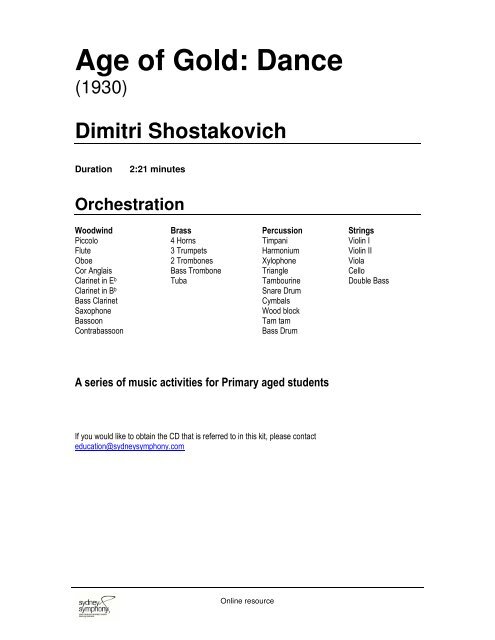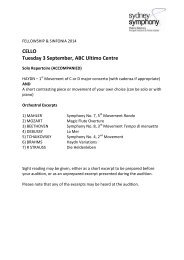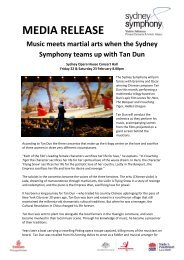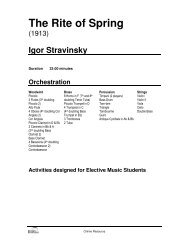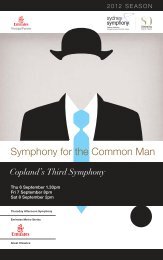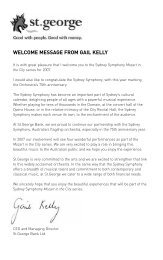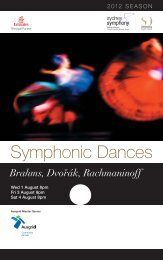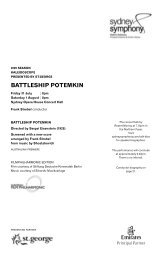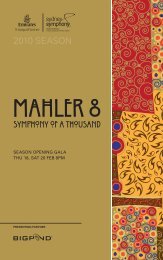Download the Shostakovich Age Of Gold Dance (Primary) PDF
Download the Shostakovich Age Of Gold Dance (Primary) PDF
Download the Shostakovich Age Of Gold Dance (Primary) PDF
Create successful ePaper yourself
Turn your PDF publications into a flip-book with our unique Google optimized e-Paper software.
<strong>Age</strong> of <strong>Gold</strong>: <strong>Dance</strong><br />
(1930)<br />
Dimitri <strong>Shostakovich</strong><br />
Duration 2:21 minutes<br />
Orchestration<br />
Woodwind<br />
Piccolo<br />
Flute<br />
Oboe<br />
Cor Anglais<br />
Clarinet in Eb Clarinet in Bb Bass Clarinet<br />
Saxophone<br />
Bassoon<br />
Contrabassoon<br />
Brass<br />
4 Horns<br />
3 Trumpets<br />
2 Trombones<br />
Bass Trombone<br />
Tuba<br />
Online resource<br />
Percussion<br />
Timpani<br />
Harmonium<br />
Xylophone<br />
Triangle<br />
Tambourine<br />
Snare Drum<br />
Cymbals<br />
Wood block<br />
Tam tam<br />
Bass Drum<br />
A series of music activities for <strong>Primary</strong> aged students<br />
If you would like to obtain <strong>the</strong> CD that is referred to in this kit, please contact<br />
education@sydneysymphony.com<br />
Strings<br />
Violin I<br />
Violin II<br />
Viola<br />
Cello<br />
Double Bass
Background<br />
Dimitri <strong>Shostakovich</strong><br />
(1906-1975)<br />
<strong>Shostakovich</strong> was born in St Petersburg. He studied piano with his mo<strong>the</strong>r,<br />
a professional pianist, until he entered <strong>the</strong> Petrograd Conservatory in 1919<br />
where he studied piano and composition. His graduation piece, Symphony<br />
No.1, was first performed to great acclaim in 1926.<br />
<strong>Shostakovich</strong>’s career was affected by <strong>the</strong> political climate of his time. The<br />
Soviet government had a policy of ‘socialist realism’ which required art to<br />
depict <strong>the</strong> triumph of <strong>the</strong> political regime and <strong>the</strong> optimism of Soviet life. His<br />
second opera, Lady Macbeth of <strong>the</strong> Mtsensk District, was initially received<br />
with acclaim in Russia, Western Europe and <strong>the</strong> USA. However, it was later<br />
denounced in Pravda (<strong>the</strong> state newspaper) as demonstrating Western<br />
decadence and causing offence to <strong>the</strong> Soviet people.<br />
He was returned to favour with his Symphony No.5 (1937) which was subtitled ‘A Soviet artist’s creative<br />
reply to just criticism’. He received official recognition and commendation from his fellow composers in 1940<br />
when he won <strong>the</strong> Stalin prize for his Piano Quintet. Unfortunately this official recognition was short-lived and<br />
he fell from favour again in 1948, accused of writing music that could not be enjoyed by <strong>the</strong> masses. After<br />
Stalin’s death in 1953 cultural restraints were relaxed and this is <strong>the</strong> period in which Symphony No.10 was<br />
completed.<br />
<strong>Shostakovich</strong> is a significant 20th Century composer whose works are constantly performed. His output<br />
includes fifteen symphonies; concertos for violin, piano and for cello; two operas; three ballets; fifteen string<br />
quartets; many vocal works; as well as works for solo piano.<br />
<strong>Age</strong> of <strong>Gold</strong>: <strong>Dance</strong><br />
<strong>Shostakovich</strong> extracted a Suite of four pieces from his unsuccessful ballet, <strong>Age</strong> of <strong>Gold</strong>. It was first<br />
performed in Leningrad in March, 1930. The four pieces are: Introduction, Adagio, Polka, and <strong>Dance</strong>.<br />
In Russia, Stalin took control of all music and art and used it to support <strong>the</strong> rise of communism.<br />
<strong>Shostakovich</strong> felt a constant struggle to maintain his favour with <strong>the</strong> politicians and his desire to express his<br />
own opinions. His ballet The <strong>Age</strong> of <strong>Gold</strong> is an example of political propaganda. It is an allegory for<br />
communism’s defeat of capitalism as depicted through a soccer game. It is one of <strong>the</strong> few ballets to<br />
concentrate its attention on a Soviet football team, here competing at <strong>the</strong> <strong>Gold</strong>en <strong>Age</strong> Industrial Exhibition in<br />
some Western capitalist city.<br />
The Suite includes satirical elements from <strong>the</strong> original score. The last Movement is a loud, boisterous<br />
Russian <strong>Dance</strong>. Its music is associated with <strong>the</strong> soccer team in <strong>the</strong> ballet and clearly exhibits <strong>the</strong> influence<br />
of Stravinsky’s ballet Petrushka.<br />
Online Resource
Learning Outcomes<br />
Students will:<br />
• play music using percussion instruments and o<strong>the</strong>r sound sources to explore and<br />
demonstrate <strong>the</strong> concepts of duration, tone colour, pitch, dynamics and structure in groups<br />
and individually<br />
.<br />
• explore basic aspects of musical concepts in <strong>the</strong>ir singing, playing and moving activities.<br />
• improvise and explore musical ideas based on rhythmic or melodic patterns and<br />
incorporates <strong>the</strong>se into own compositions.<br />
• explore ways of varying musical material.<br />
• Organise <strong>the</strong>ir own musical ideas into simple compositions.<br />
• devise symbols to represent sounds for use in graphic notation and perform from <strong>the</strong>ir own<br />
scores.<br />
• identify basic musical features of music that is performed and listened to.<br />
• discuss <strong>the</strong> composer’s use of <strong>the</strong>se aspects in contrasting sections of <strong>the</strong> music.<br />
Online resource
Listening Guide<br />
Bar CD Cues Features<br />
1-28 0:00-0:26 • Allegro, very fast and lively.<br />
• Syncopated introduction by harmonium and strings.<br />
• Theme 1 in high register played by upper woodwinds.<br />
• Wood block and tambourine join accompaniment.<br />
29-52 0:27-0:49 • The rest of <strong>the</strong> orchestra enters.<br />
• Theme 2. The first part of <strong>the</strong> <strong>the</strong>me is played by upper woodwinds, trumpets,<br />
harmonium and upper strings, <strong>the</strong> second part by lower woodwinds, bass<br />
trombone and tuba.<br />
53-75 0:50-1:10 • Quieter Theme 3 in high register played by piccolo, flute, piccolo clarinet and<br />
harmonium.<br />
• Reduced accompaniment in horn and strings.<br />
76-108 1:11-1:41 • Theme 4 played by lower strings, bassoons and contrabassoon.<br />
• Violins play a countermelody above.<br />
• Accompanied by woodwinds and harmonium.<br />
• Section continues with alternating passages between brass and<br />
woodwinds/strings.<br />
109-116 1:42-1:49 • Short Theme 5 in upper woodwinds with syncopated accompaniment in<br />
strings and harmonium.<br />
117-136 1:50-2:09 • Whole orchestra plays.<br />
• Low Theme 6 played by lower woodwinds, trombones, tuba, cellos and<br />
double basses.<br />
• Builds to <strong>the</strong> closing section.<br />
137-149 2:10-2:21 • Coda. Closing section played by whole orchestra.<br />
• Rapid scale passages in woodwinds and upper strings and melody in bass<br />
trombone and tuba lead to one last trill and <strong>the</strong> final chords of <strong>the</strong> <strong>Dance</strong>.<br />
Online Resource
Listening<br />
Listen to <strong>the</strong> CD recording of <strong>Dance</strong> from <strong>Age</strong> of <strong>Gold</strong>.<br />
1. This piece is called <strong>Dance</strong> and is from a ballet by <strong>the</strong> Russian composer Dimitri <strong>Shostakovich</strong>.<br />
(a) Clap <strong>the</strong> beat and describe <strong>the</strong> tempo.<br />
(b) How fast would <strong>the</strong> dancers need to dance to fit <strong>the</strong> tempo?<br />
2. (a) What is <strong>the</strong> mood of <strong>the</strong> piece?<br />
(b) Is it serious? Why/why not? (It is not perceived as serious. The composer’s intention was to<br />
make a satirical comment on communism.)<br />
(c) What type of dance actions does <strong>the</strong> music suggest and why?<br />
(d) Discuss <strong>the</strong> subject of <strong>the</strong> ballet. (It is about a soccer game).<br />
3. (a) Identify <strong>the</strong> instruments that play and list <strong>the</strong>m in families of instruments.<br />
(b) Compare your answer with <strong>the</strong> instrument list at <strong>the</strong> start of <strong>the</strong> activitiy.<br />
4. In <strong>the</strong> piece <strong>the</strong>re are several short <strong>the</strong>mes.<br />
(a) Identify <strong>the</strong> <strong>the</strong>mes that are played in a high register and those played in a low register. (See<br />
Listening Guide on Page 60.)<br />
Theme 1 High<br />
Theme 2 High and low<br />
Theme 3 High<br />
Theme 4 Low (with high countermelody)<br />
Theme 5 High<br />
Theme 6 Low<br />
(b) Are <strong>the</strong>re any differences in <strong>the</strong> rhythms of <strong>the</strong> high and low <strong>the</strong>mes? (Higher <strong>the</strong>mes have<br />
more notes, many semiquavers); lower <strong>the</strong>mes have less notes (quavers and crotchets).)<br />
(c) Discuss possible reasons for this. (eg, it is too hard to play rapid passages on lower<br />
instruments, especially trombones and tuba.)<br />
Online resource
Performing/Organising Sound<br />
1. The rhythm below is used to accompany Theme 1 of <strong>Dance</strong>. It is played by <strong>the</strong> wood block and<br />
tambourine.<br />
(a) Learn to play <strong>the</strong> rhythms separately using body percussion. Begin with <strong>the</strong> tambourine<br />
rhythm.<br />
(b) Perform <strong>the</strong> rhythms toge<strong>the</strong>r.<br />
(c) Transfer <strong>the</strong> rhythms to non-melodic percussion instruments (wood blocks and tambourines if<br />
available).<br />
(d) Select students to perform <strong>the</strong> rhythms with <strong>the</strong> CD recording, CD cue 0:00-0:26. (Percussion<br />
instruments enter after four bars with <strong>the</strong> melody.)<br />
2. Students improvise 4 bar melodies in 2 4 time above <strong>the</strong> accompaniment on melodic instruments set<br />
up in C major (C D E F G A B C).<br />
3. (a) Learn to play <strong>the</strong> melody below on available instruments. This is <strong>the</strong> first part of <strong>the</strong> low<br />
Theme 6.<br />
(b) Listen to <strong>the</strong> CD recording of this section, CD cue 1:50-2:09, and identify <strong>the</strong> <strong>the</strong>me as it is<br />
played.<br />
(c) In pairs, one student plays <strong>the</strong> first part of <strong>the</strong> <strong>the</strong>me; <strong>the</strong> second student improvises a new<br />
second part of <strong>the</strong> <strong>the</strong>me on a melodic instrument set up in C major.<br />
(d) Students swap roles.<br />
Online Resource
4. (a) Working in pairs, students notate a new ending of <strong>the</strong> <strong>the</strong>me using traditional or non-traditional<br />
notation.<br />
(b) Practise and perform <strong>the</strong> piece for <strong>the</strong> class.<br />
5. Accompany <strong>the</strong> students’ compositions with <strong>the</strong> tambourine and wood block rhythms (or students<br />
devise new accompaniment patterns of <strong>the</strong>ir own.)<br />
6. Once you can perform <strong>the</strong>se compositions create a dance that reflects in movement <strong>the</strong> shape of your<br />
tune and structure of your piece.<br />
Online resource


